introduction To iaido and Kendo

| ◊ Introduction To Iaido and Kendo |

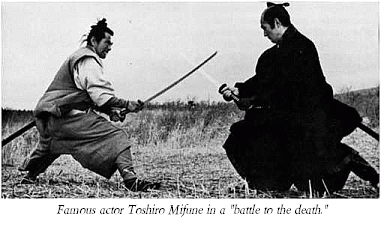
 * The Omori ryu is the beginning and foundational set of Iaido techniques. It is considered the Shoden, or First Level, and is often called the Seiza-no-bu, or section performed in seiza, the formal Japanese sitting position with both feet tucked under and the buttocks resting on the feet. It consists of 11 or 12 techniques, with all but one performed from seiza. The other technique is performed standing.
* The Omori ryu is the beginning and foundational set of Iaido techniques. It is considered the Shoden, or First Level, and is often called the Seiza-no-bu, or section performed in seiza, the formal Japanese sitting position with both feet tucked under and the buttocks resting on the feet. It consists of 11 or 12 techniques, with all but one performed from seiza. The other technique is performed standing.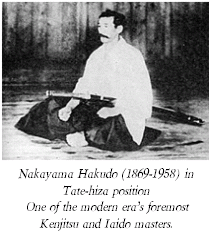 * The Hasagawa Eiishin-ryu or Eiishin-ryu is the middle level, or Chuden, set of Iaido techniques. It is also sometimes called Hiza-no-bu because most of it is performed in the tate-hiza stance, a sitting position in which one knee is raised. This position harks back to the days when samurai wore armor, which made sitting in seiza impractical. The Eiishin-ryu consists of 10 or 11 techniques, the last of which is performed in seiza.
* The Hasagawa Eiishin-ryu or Eiishin-ryu is the middle level, or Chuden, set of Iaido techniques. It is also sometimes called Hiza-no-bu because most of it is performed in the tate-hiza stance, a sitting position in which one knee is raised. This position harks back to the days when samurai wore armor, which made sitting in seiza impractical. The Eiishin-ryu consists of 10 or 11 techniques, the last of which is performed in seiza.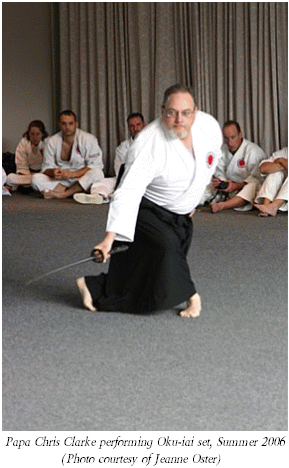 * The Joden, or upper-level set of Iaido techniques is the Okuden, or "secret-level" group, which consists of two sets. The first, called Suwari-waza, or "seated techniques," is composed of specialized defenses from a sitting position. The second section, called Tachi-waza or Tachi-iai (standing techniques) consists of 10 techniques, all done standing or walking, with a supplementary set of three techniques done in seiza called Itomagoi (or "Farewell Visit"). Deceptively simple on the surface, these techniques require exquisite timing and technique. They represent the closest to realistic combat situations of all the Iaido sets.
* The Joden, or upper-level set of Iaido techniques is the Okuden, or "secret-level" group, which consists of two sets. The first, called Suwari-waza, or "seated techniques," is composed of specialized defenses from a sitting position. The second section, called Tachi-waza or Tachi-iai (standing techniques) consists of 10 techniques, all done standing or walking, with a supplementary set of three techniques done in seiza called Itomagoi (or "Farewell Visit"). Deceptively simple on the surface, these techniques require exquisite timing and technique. They represent the closest to realistic combat situations of all the Iaido sets.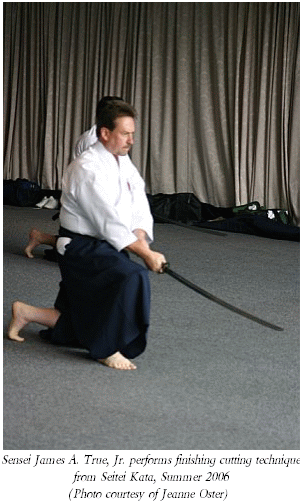 * The SKKAA also performs the Zen Nihon Renmei Seitei Kata Iai series, the standard set performed by all Iaido students in Japan and the one on which grading and competition generally are based. (The name means "All Japan Federation Standard Iai Form".) It consists of ten techniques, the first three of which are taken from the Omori-ryu and the fourth from the Eiishin-ryu. The remainder were taken from various schools of Iaido and Iaijitsu when the form was put together in the 1950s.
* The SKKAA also performs the Zen Nihon Renmei Seitei Kata Iai series, the standard set performed by all Iaido students in Japan and the one on which grading and competition generally are based. (The name means "All Japan Federation Standard Iai Form".) It consists of ten techniques, the first three of which are taken from the Omori-ryu and the fourth from the Eiishin-ryu. The remainder were taken from various schools of Iaido and Iaijitsu when the form was put together in the 1950s.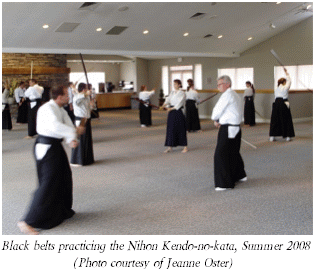
 * Some members of the SKKAA also practice the Zen Nihon Kendo Renmei Nihon Kendo no Kata, or "All Japan Kendo Federation Kendo Form," a two person form involving a series of attacks and defenses using the bokken. The first seven of these techniques involve defending against a long-sword (katana) attack with a long sword (katana), while the last three involve defending against a katana attack with a short sword (wakizashi).
* Some members of the SKKAA also practice the Zen Nihon Kendo Renmei Nihon Kendo no Kata, or "All Japan Kendo Federation Kendo Form," a two person form involving a series of attacks and defenses using the bokken. The first seven of these techniques involve defending against a long-sword (katana) attack with a long sword (katana), while the last three involve defending against a katana attack with a short sword (wakizashi). Iaido is replete with formality and etiquette. It is always performed wearing formal Japanese pleated "trousers" (hakama) and a keiko-gi top. Individual school traditions dictate minutiae of how to carry the sword, how to sit, how to rise, how to bow, how to affix the sword, etc. The techniques of Iaido, no matter which set is being performed, consist of drawing the sword (nukistuke), cutting or striking (kiri-tsuke), removal of blood from the sword (chiburi), and re-sheathing the sword (noto).
Iaido is replete with formality and etiquette. It is always performed wearing formal Japanese pleated "trousers" (hakama) and a keiko-gi top. Individual school traditions dictate minutiae of how to carry the sword, how to sit, how to rise, how to bow, how to affix the sword, etc. The techniques of Iaido, no matter which set is being performed, consist of drawing the sword (nukistuke), cutting or striking (kiri-tsuke), removal of blood from the sword (chiburi), and re-sheathing the sword (noto).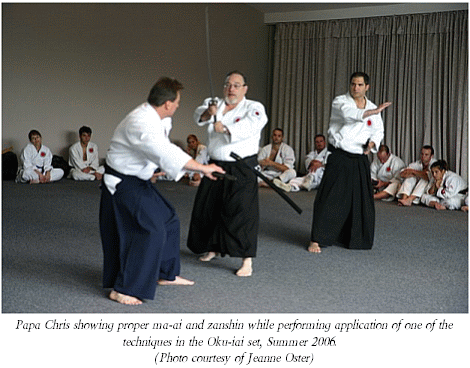 Key concepts learned from Iaido include ma-ai (understanding of distance), zanshin ("lingering gaze" or complete awareness and residing "in the moment"), jo-ha-kyu ("slow, medium, fast" or "beginning, middle, and end," which distinguish between the attitude and movements throughout each technique), and in-yo (or "Yin and Yang," the differentiation between soft and hard, yielding and asserting).
Key concepts learned from Iaido include ma-ai (understanding of distance), zanshin ("lingering gaze" or complete awareness and residing "in the moment"), jo-ha-kyu ("slow, medium, fast" or "beginning, middle, and end," which distinguish between the attitude and movements throughout each technique), and in-yo (or "Yin and Yang," the differentiation between soft and hard, yielding and asserting).